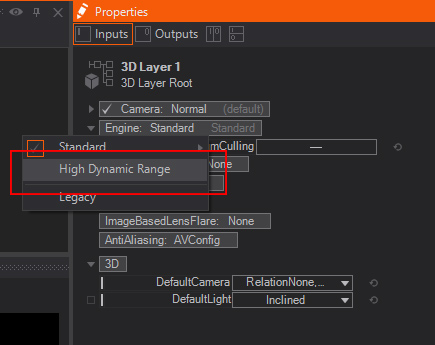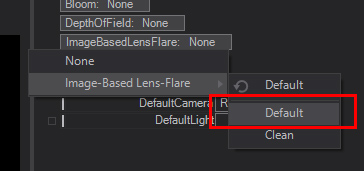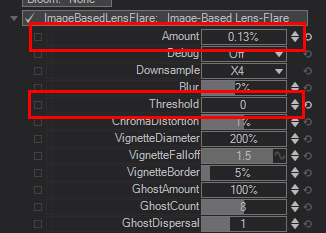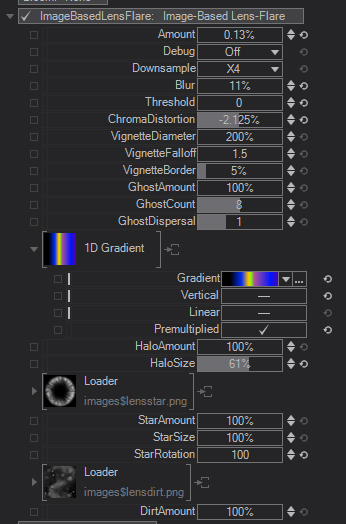How To Create Lens Flares and Bloom
Table of Contents
Introduction
Ventuz has a built in effect for Lens Flares, so called Image based Lens Flares and a Bloom Effect which creates a halo around very bright or glowing elements. The optimal procedure is to have the Ventuz engine in HDR mode. Only with the HDR mode it is possible to have the elements, that should create a Lens Flare or Bloom, shift into the higher dynamic range. This shifting will let these elements that are way brighter than the displayable white, glow or create the flares, while other bright or white objects will not!
Preparation
Please switch the 3D Layer's engine to HDR mode.
- Select the 3D Layer Root node - the very first node in the Hierarchy Editor in every 3D Layer.
- Inside the Properties Editor, you will find a dropdown menu for the Engine.
- Click on Engine:Standard to bring up the selection menu and click High Dynamic Range.

When switching from Standard to HDR, the overall colors will have a slight variation due to the nature of the HDR Mode.
When the HDR Engine is enabled, you will see additional properties such as: Exposure, Dither, FrustumCulling and another dropdown menu for the ToneMapping selection as well as another set of properties depending on the selected ToneMapping mode.
For both scenarios - Lens Flares and Bloom - we need at least one object which is very bright and shifted into the upper dynamic range.
To do so create an axis and a sphere with an applied material node. The material node should have at least a Color material stage and the Color target: Emissive and the amount set to 10000:

Aside from the sphere being just bright, we have adjusted the amount to be 10000%. This looks weird in the first place, but will internally have the sphere a lot brighter than the white that is displayable on your screen. This is a good way to seperate white objects from bright objects, so we can select with IBL-Effects what should be "lit or create a lens-flare".
Lens Flares
Select the 3D Layer Root node and select the default ImageBasedLensFlare.

At first look you will notice the lens flares are way too intense. This can be adjusted by decreasing the Amount for the Lens Flares - there are some other values that help with a good looking lens flare effect. Decrease both the Amount: 0.13 and Threshold: 0:

The lens flare can work with this very low amount since we have set the Sphere to have an emmisive value of 10000%. This is not only white but really bright. We set the Threshold to 0 and the Amount to 0.13. By setting the Threshold to 0 we filter the whole image, we do not clip at any brightness and use the whole range to be used by the IPP-Effect. This way we can make use of the full dynamic range of our rendering and select the very bright objects. Because of that we have to lower the Amount for the Lens Flare - and still, the used 0.13% are enough to have the sphere create a flare - You can check whats affecting the lens flare by selecting the Debug: Mask option. This will show you the result of the Mask by the actual threshold.
We can still adjust several settings to create a good looking Lens Flare Effect with the following values:
| Amount: | 0.13% |
| Blur: | 11% |
| ChromaDistortion: | -2.125 |
Instead of the built in "Loader" for the Gradient we use a custom 1D Gradient with the following string:

If you move the camera around in the free flight mode, you will see how nice the lens flare will behave.
Bloom
Select the 3D Layer Root node and select Bloom: Bloom. This will enable a global bloom effect on the rendering of the 3D Layer.
It depends on how intense you would like to have the Bloom applied to the rendering. Generally it is the same like with the IBL-Lens Flares and you start with very low values, since the sphere is already very bright.
Set the Threshold: 0 and the Amount: 0.3. This will create an intense bloom for the sphere. If you find the bloom is too intense in your case and brightens up areas of your rendering where you dont want to have it: reduce the Amount. To check what affects the bloom set Show: Mask which will show you the content of the filtered rendering.
Conclusion
By using a high-percentage for an Emmisive Amount you shift objects into the Higher Dynamic Range. If you do so, you can make use of the IPP Effects to explicitly select them and apply a Lens Flare or Bloom. Requirement for this is to have the HDR Mode for the engine enabled.